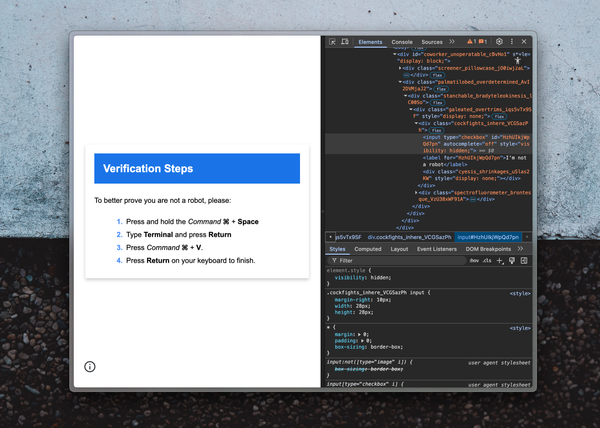My Neovim setup for React, TypeScript, Tailwind CSS, etc in 2022
Hi, it’s Takuya here. As you may know, I mainly use Neovim to code my app called Inkdrop, a cross-platform Markdown note-taking app. It’s…
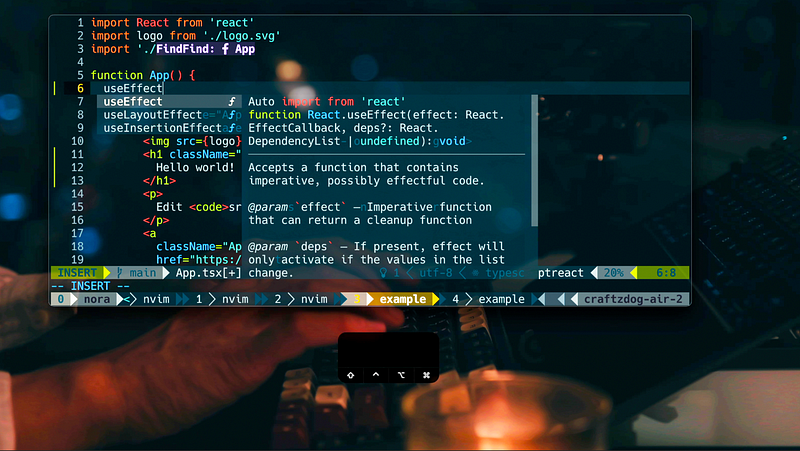
My Neovim setup for React, TypeScript, Tailwind CSS, etc
Hi, it’s Takuya here. As you may know, I mainly use Neovim to code my app called Inkdrop, a cross-platform Markdown note-taking app. It’s built with Electron for desktop and React Native for mobile platforms. It’s been 1 year since I last posted my Neovim setup. Neovim and its plugins have been evolved so well. So, I’d like to share my latest setup for coding React and TypeScript based apps. The main difference is that the config files are now written in Lua. I switched from vim-plug to Packer. I also made a tutorial video on how to set up Neovim from scratch on a new M2 MacBook Air. If you have your own dotfiles already, you can cherry-pick my config. I hope you enjoy it!
Ingredients
Here is a quick summary of my set up:
- Neovim >= 0.7
- wbthomason/packer.nvim — A plugin manager for Neovim
- svrana/neosolarized.nvim — A truecolor, solarized dark colorscheme
- nvim-lualine/lualine.nvim — A blazing fast and easy to configure Neovim statusline written in Lua
- onsails/lspkind-nvim — VSCode-like pictograms
- L3MON4D3/LuaSnip — Snippet Engine for Neovim written in Lua
- hrsh7th/cmp-nvim-lsp — nvim-cmp source for neovim’s built-in LSP
- hrsh7th/cmp-buffer — nvim-cmp source for buffer words
- hrsh7th/nvim-cmp — A completion engine plugin for neovim written in Lua
- neovim/nvim-lspconfig — A collection of configurations for Neovim’s built-in LSP
- jose-elias-alvarez/null-ls.nvim — Use Neovim as a language server to inject LSP diagnostics, code actions, and more via Lua.
- MunifTanjim/prettier.nvim - Prettier plugin for Neovim's built-in LSP client
- williamboman/mason.nvim - Portable package manager for Neovim that runs everywhere Neovim runs. Easily install and manage LSP servers, DAP servers, linters, and formatters
- williamboman/mason-lspconfig.nvim - Extension to mason.nvim that makes it easier to use lspconfig with mason.nvim
- glepnir/lspsaga.nvim - A light-weight lsp plugin based on neovim's built-in lsp with a highly performant UI
- nvim-treesitter/nvim-treesitter - Treesitter configurations and abstraction layer for Neovim
- kyazdani42/nvim-web-devicons - Lua
forkof vim-web-devicons for neovim - nvim-telescope/telescope.nvim - A highly extendable fuzzy finder over lists
- nvim-telescope/telescope-file-browser.nvim - File Browser extension for telescope.nvim
- windwp/nvim-autopairs - Autopairs
- windwp/nvim-ts-autotag - Use treesitter to auto close and auto rename html tag
- norcalli/nvim-colorizer.lua - A high-performance color highlighter
- akinsho/nvim-bufferline.lua - A snazzy bufferline
- lewis6991/gitsigns.nvim - Git integration for buffers
- dinhhuy258/git.nvim - A simple clone of the plugin vim-fugitive
- folke/zen-mode.nvim - Distraction-free mode
- iamcco/markdown-preview.nvim - Markdown live preview
And here is my dotfiles repository:

A tutorial video (YouTube):
Prerequisites — iTerm2 and Patched Nerd Font
iTerm2 is a fast terminal emulator for macOS. Install one of Nerd Fonts for displaying fancy glyphs on your terminal. My current choice is Hack. And use it on your terminal app. For example, on iTerm2:
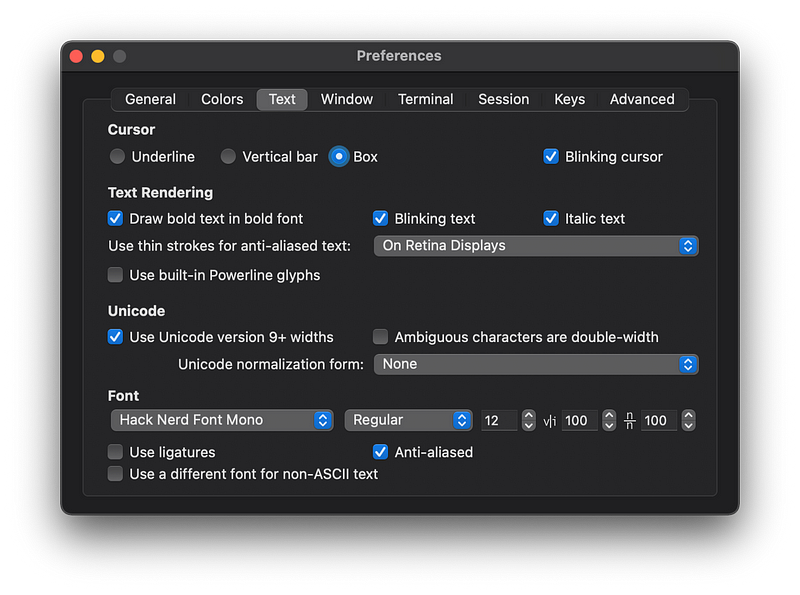
Install Neovim via Homebrew
It’s simple:
brew install neovimDirectory structure
Neovim conforms XDG Base Directory structure. Here is my config file structure:
📂 ~/.config/nvim
├── 📁 after
│ └── 📁 plugin
├── 📂 lua
│ └── 🌑 base.lua
├── 📁 plugin
└── 🇻 init.luaNeovim loads $HOME/.config/nvim/init.vim or init.lua first instead of $HOME/.vimrc. Check out the quickstart guide for more detail:
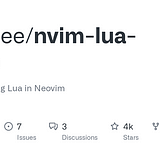
Install plugin manager: Packer
Install Packer by running the below command:
git clone --depth 1 https://github.com/wbthomason/packer.nvim \
~/.local/share/nvim/site/pack/packer/start/packer.nvimThen, make ./.config/nvim/lua/plugins.lua like so:
local status, packer = pcall(require, "packer")
if (not status) then
print("Packer is not installed")
return
end
vim.cmd [[packadd packer.nvim]]
packer.startup(function(use)
use 'wbthomason/packer.nvim'
-- Your plugins go here
end)Then, require it from init.lua like so:
require('plugins')Color scheme: Neosolarized
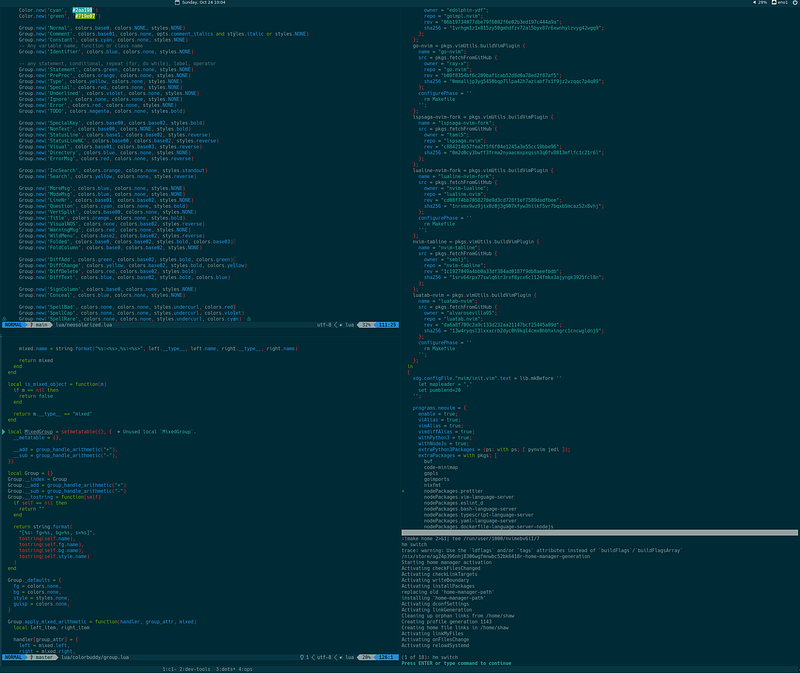
I use svrana/neosolarized.nvim with some customizations.
local status, n = pcall(require, "neosolarized")
if (not status) then return end
n.setup({
comment_italics = true,
})
local cb = require('colorbuddy.init')
local Color = cb.Color
local colors = cb.colors
local Group = cb.Group
local groups = cb.groups
local styles = cb.styles
Color.new('black', '#000000')
Group.new('CursorLine', colors.none, colors.base03, styles.NONE, colors.base1)
Group.new('CursorLineNr', colors.yellow, colors.black, styles.NONE, colors.base1)
Group.new('Visual', colors.none, colors.base03, styles.reverse)
local cError = groups.Error.fg
local cInfo = groups.Information.fg
local cWarn = groups.Warning.fg
local cHint = groups.Hint.fg
Group.new("DiagnosticVirtualTextError", cError, cError:dark():dark():dark():dark(), styles.NONE)
Group.new("DiagnosticVirtualTextInfo", cInfo, cInfo:dark():dark():dark(), styles.NONE)
Group.new("DiagnosticVirtualTextWarn", cWarn, cWarn:dark():dark():dark(), styles.NONE)
Group.new("DiagnosticVirtualTextHint", cHint, cHint:dark():dark():dark(), styles.NONE)
Group.new("DiagnosticUnderlineError", colors.none, colors.none, styles.undercurl, cError)
Group.new("DiagnosticUnderlineWarn", colors.none, colors.none, styles.undercurl, cWarn)
Group.new("DiagnosticUnderlineInfo", colors.none, colors.none, styles.undercurl, cInfo)
Group.new("DiagnosticUnderlineHint", colors.none, colors.none, styles.undercurl, cHint)Status line: Lualine

nvim-lualine/lualine.nvim provides a flexible way to configure statusline.
local status, lualine = pcall(require, "lualine")
if (not status) then return end
lualine.setup {
options = {
icons_enabled = true,
theme = 'solarized_dark',
section_separators = { left = '', right = '' },
component_separators = { left = '', right = '' },
disabled_filetypes = {}
},
sections = {
lualine_a = { 'mode' },
lualine_b = { 'branch' },
lualine_c = { {
'filename',
file_status = true, -- displays file status (readonly status, modified status)
path = 0 -- 0 = just filename, 1 = relative path, 2 = absolute path
} },
lualine_x = {
{ 'diagnostics', sources = { "nvim_diagnostic" }, symbols = { error = ' ', warn = ' ', info = ' ',
hint = ' ' } },
'encoding',
'filetype'
},
lualine_y = { 'progress' },
lualine_z = { 'location' }
},
inactive_sections = {
lualine_a = {},
lualine_b = {},
lualine_c = { {
'filename',
file_status = true, -- displays file status (readonly status, modified status)
path = 1 -- 0 = just filename, 1 = relative path, 2 = absolute path
} },
lualine_x = { 'location' },
lualine_y = {},
lualine_z = {}
},
tabline = {},
extensions = { 'fugitive' }
}Lspconfig
Neovim has a built-in LSP support. You can easily configure it by using neovim/nvim-lspconfig. For example, to enable typescript language server on Neovim:
local status, nvim_lsp = pcall(require, "lspconfig")
if (not status) then return end
local protocol = require('vim.lsp.protocol')
local on_attach = function(client, bufnr)
-- format on save
if client.server_capabilities.documentFormattingProvider then
vim.api.nvim_create_autocmd("BufWritePre", {
group = vim.api.nvim_create_augroup("Format", { clear = true }),
buffer = bufnr,
callback = function() vim.lsp.buf.formatting_seq_sync() end
})
end
end
-- TypeScript
nvim_lsp.tsserver.setup {
on_attach = on_attach,
filetypes = { "typescript", "typescriptreact", "typescript.tsx" },
cmd = { "typescript-language-server", "--stdio" }
}Don't forget to install typescript language server itself:
npm i -g typescript-language-serverAuto-completion: Lspkind and cmp
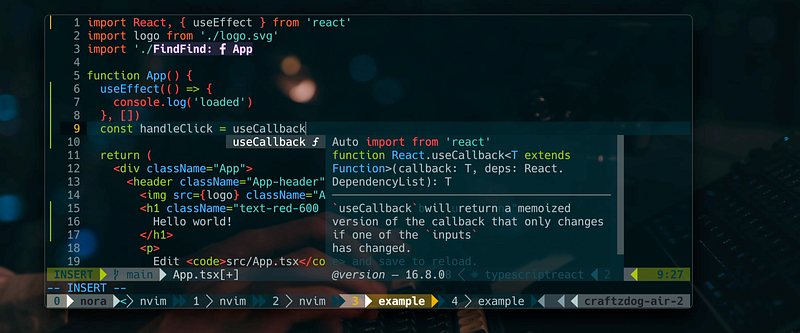
To get LSP-aware auto-completion feature with fancy pictograms, I use the following plugins:
- onsails/lspkind-nvim - VSCode-like pictograms
- L3MON4D3/LuaSnip - Snippet engine
- hrsh7th/cmp-nvim-lsp - nvim-cmp source for neovim's built-in LSP
- hrsh7th/cmp-buffer - nvim-cmp source for buffer words
- hrsh7th/nvim-cmp - A completion engine plugin for neovim
Configure it like so:
local status, cmp = pcall(require, "cmp")
if (not status) then return end
local lspkind = require 'lspkind'
cmp.setup({
snippet = {
expand = function(args)
require('luasnip').lsp_expand(args.body)
end,
},
mapping = cmp.mapping.preset.insert({
['<C-d>'] = cmp.mapping.scroll_docs(-4),
['<C-f>'] = cmp.mapping.scroll_docs(4),
['<C-Space>'] = cmp.mapping.complete(),
['<C-e>'] = cmp.mapping.close(),
['<CR>'] = cmp.mapping.confirm({
behavior = cmp.ConfirmBehavior.Replace,
select = true
}),
}),
sources = cmp.config.sources({
{ name = 'nvim_lsp' },
{ name = 'buffer' },
}),
formatting = {
format = lspkind.cmp_format({ with_text = false, maxwidth = 50 })
}
})
vim.cmd [[
set completeopt=menuone,noinsert,noselect
highlight! default link CmpItemKind CmpItemMenuDefault
]]Syntax highlightings: Treesitter
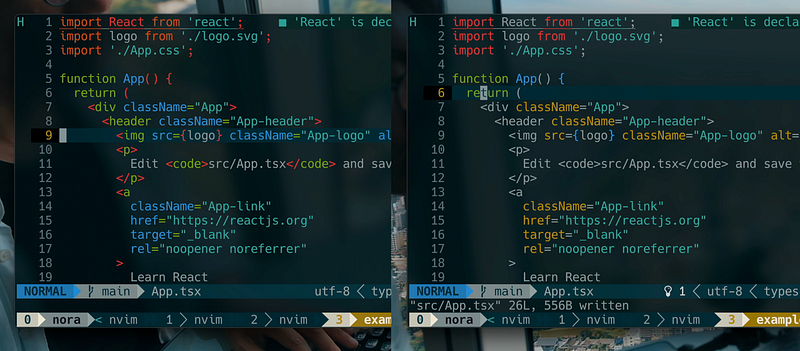
Treesitter is a popular language parser for syntax highlightings. First, install it:
brew install tree-sitterInstall nvim-treesitter/nvim-treesitter with Packer and configure it like so:
local status, ts = pcall(require, "nvim-treesitter.configs")
if (not status) then return end
ts.setup {
highlight = {
enable = true,
disable = {},
},
indent = {
enable = true,
disable = {},
},
ensure_installed = {
"tsx",
"toml",
"fish",
"php",
"json",
"yaml",
"swift",
"css",
"html",
"lua"
},
autotag = {
enable = true,
},
}
local parser_config = require "nvim-treesitter.parsers".get_parser_configs()
parser_config.tsx.filetype_to_parsername = { "javascript", "typescript.tsx" }Autotag and Autopair
For React apps, you often want to close tags quickly. windwp/nvim-ts-autotag is exactly what you want.
local status, autotag = pcall(require, "nvim-ts-autotag")
if (not status) then return end
autotag.setup({})windwp/nvim-autopairs is for closing brackets.
local status, autopairs = pcall(require, "nvim-autopairs")
if (not status) then return end
autopairs.setup({
disable_filetype = { "TelescopePrompt" , "vim" },
})Fuzz finder: Telescope
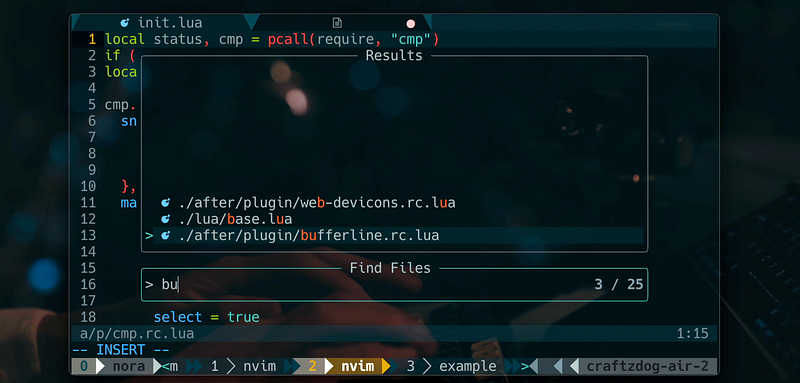
telescope.nvim provides an interactive fuzzy finder over lists, built on top of the latest Neovim features. I also use telescope-file-browser.nvim as a filer.
It’s so useful because you can search files while viewing the content of the files without actually opening them. It supports various sources like Vim, files, Git, LSP, and Treesitter. Check out the showcase of Telescope.
Install kyazdani42/nvim-web-devicons to get file icons on Telescope, statusline, and other supported plugins.
The configuration would look like so:
local status, telescope = pcall(require, "telescope")
if (not status) then return end
local actions = require('telescope.actions')
local builtin = require("telescope.builtin")
local function telescope_buffer_dir()
return vim.fn.expand('%:p:h')
end
local fb_actions = require "telescope".extensions.file_browser.actions
telescope.setup {
defaults = {
mappings = {
n = {
["q"] = actions.close
},
},
},
}
-- keymaps
vim.keymap.set('n', ';f',
function()
builtin.find_files({
no_ignore = false,
hidden = true
})
end)
vim.keymap.set('n', ';r', function()
builtin.live_grep()
end)
vim.keymap.set('n', '\\\\', function()
builtin.buffers()
end)
vim.keymap.set('n', ';t', function()
builtin.help_tags()
end)
vim.keymap.set('n', ';;', function()
builtin.resume()
end)
vim.keymap.set('n', ';e', function()
builtin.diagnostics()
end)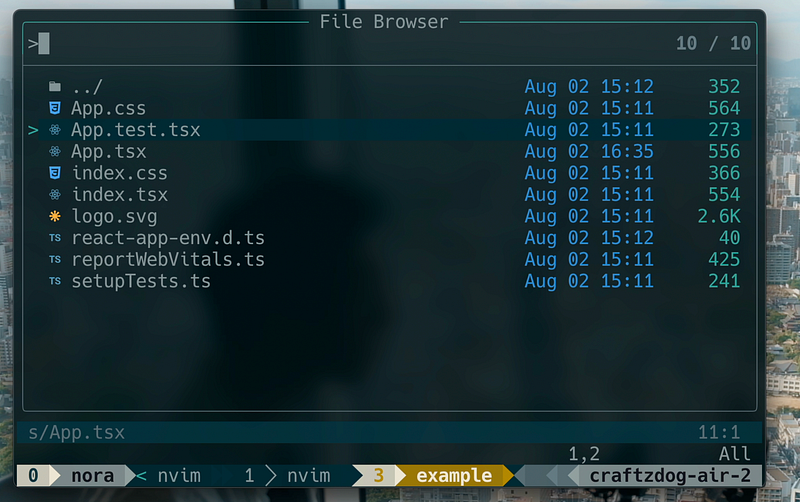
Use the telescope browser extension:
telescope.setup {
defaults = {
mappings = {
n = {
["q"] = actions.close
},
},
},
extensions = {
file_browser = {
theme = "dropdown",
-- disables netrw and use telescope-file-browser in its place
hijack_netrw = true,
mappings = {
-- your custom insert mode mappings
["i"] = {
["<C-w>"] = function() vim.cmd('normal vbd') end,
},
["n"] = {
-- your custom normal mode mappings
["N"] = fb_actions.create,
["h"] = fb_actions.goto_parent_dir,
["/"] = function()
vim.cmd('startinsert')
end
},
},
},
},
}
telescope.load_extension("file_browser")
vim.keymap.set("n", "sf", function()
telescope.extensions.file_browser.file_browser({
path = "%:p:h",
cwd = telescope_buffer_dir(),
respect_gitignore = false,
hidden = true,
grouped = true,
previewer = false,
initial_mode = "normal",
layout_config = { height = 40 }
})
end)Tabs: Bufferline

I use akinsho/nvim-bufferline.lua to get better looking of tabs. Make some customizations to make it look better with Solarized theme:
local status, bufferline = pcall(require, "bufferline")
if (not status) then return end
bufferline.setup({
options = {
mode = "tabs",
separator_style = 'slant',
always_show_bufferline = false,
show_buffer_close_icons = false,
show_close_icon = false,
color_icons = true
},
highlights = {
separator = {
guifg = '#073642',
guibg = '#002b36',
},
separator_selected = {
guifg = '#073642',
},
background = {
guifg = '#657b83',
guibg = '#002b36'
},
buffer_selected = {
guifg = '#fdf6e3',
gui = "bold",
},
fill = {
guibg = '#073642'
}
},
})
vim.keymap.set('n', '<Tab>', '<Cmd>BufferLineCycleNext<CR>', {})
vim.keymap.set('n', '<S-Tab>', '<Cmd>BufferLineCyclePrev<CR>', {})LSP Uls: Lspsaga
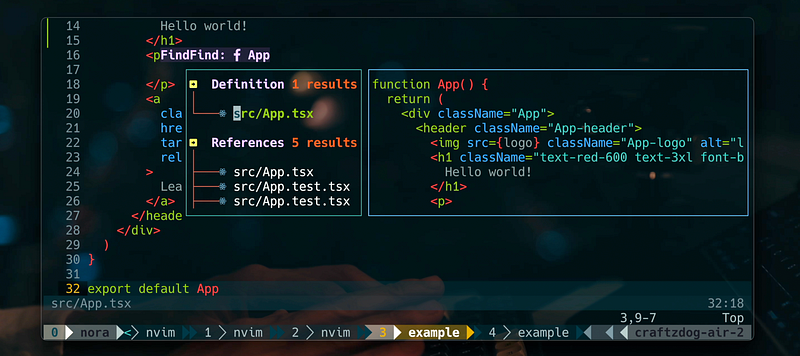
lsp_finder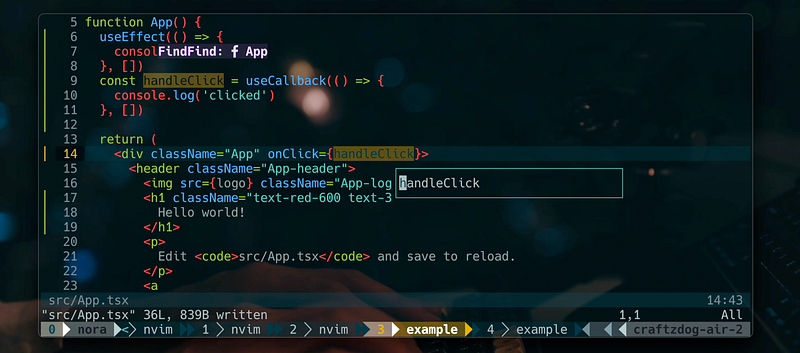
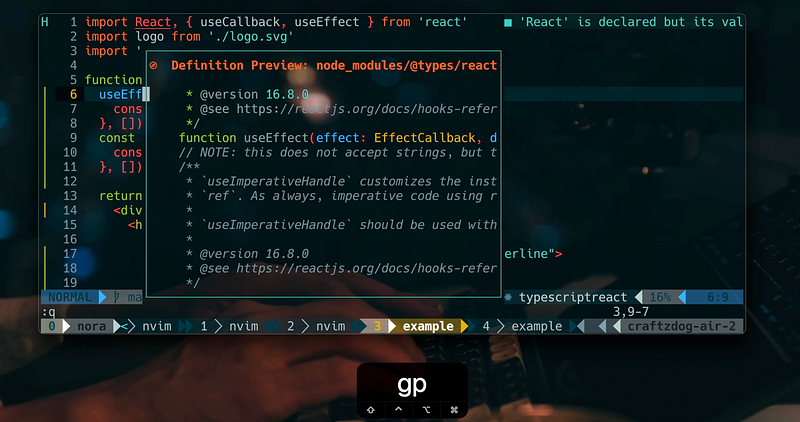
glepnir/lspsaga.nvim is one of my favorite LSP plugins. It provides beautiful UIs for various LSP-related features like hover doc, definition preview, and rename actions. My configuration is simple:
local status, saga = pcall(require, "lspsaga")
if (not status) then return end
saga.init_lsp_saga {
server_filetype_map = {
typescript = 'typescript'
}
}
local opts = { noremap = true, silent = true }
vim.keymap.set('n', '<C-j>', '<Cmd>Lspsaga diagnostic_jump_next<CR>', opts)
vim.keymap.set('n', 'K', '<Cmd>Lspsaga hover_doc<CR>', opts)
vim.keymap.set('n', 'gd', '<Cmd>Lspsaga lsp_finder<CR>', opts)
vim.keymap.set('i', '<C-k>', '<Cmd>Lspsaga signature_help<CR>', opts)
vim.keymap.set('n', 'gp', '<Cmd>Lspsaga preview_definition<CR>', opts)
vim.keymap.set('n', 'gr', '<Cmd>Lspsaga rename<CR>', opts)Code formatter: Prettier and null-ls
I heavily rely on Prettier to format TypeScript/JavaScript/CSS files. Use jose-elias-alvarez/null-ls.nvim and MunifTanjim/prettier.nvim to accomplish that.
First, you need prettierd:
brew install prettierdThen, configure null-ls as following:
local status, null_ls = pcall(require, "null-ls")
if (not status) then return end
null_ls.setup({
sources = {
null_ls.builtins.diagnostics.eslint_d.with({
diagnostics_format = '[eslint] #{m}\n(#{c})'
}),
null_ls.builtins.diagnostics.fish
}
})Prettier:
local status, prettier = pcall(require, "prettier")
if (not status) then return end
prettier.setup {
bin = 'prettierd',
filetypes = {
"css",
"javascript",
"javascriptreact",
"typescript",
"typescriptreact",
"json",
"scss",
"less"
}
}Git markers: gitsigns
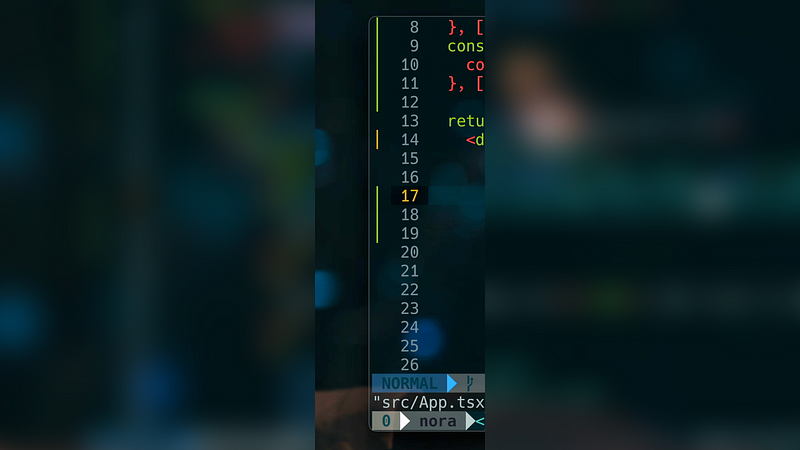
lewis6991/gitsigns.nvim provides git decorations for current buffers. It helps you know which lines are currently changed. It works out of the box.
require('gitsigns').setup {}git
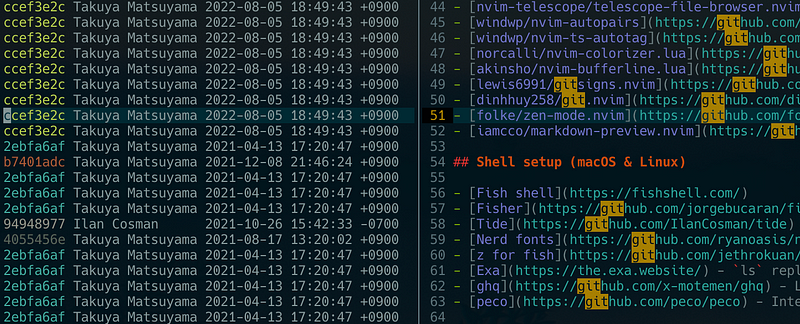
I often view the code on GitHub. dinhhuy258/git.nvim helps open GitHub right from Neovim, and provides git blame view in split view, which are super handy.
local status, git = pcall(require, "git")
if (not status) then return end
git.setup({
keymaps = {
-- Open blame window
blame = "<Leader>gb",
-- Open file/folder in git repository
browse = "<Leader>go",
}
})LSP tool: mason
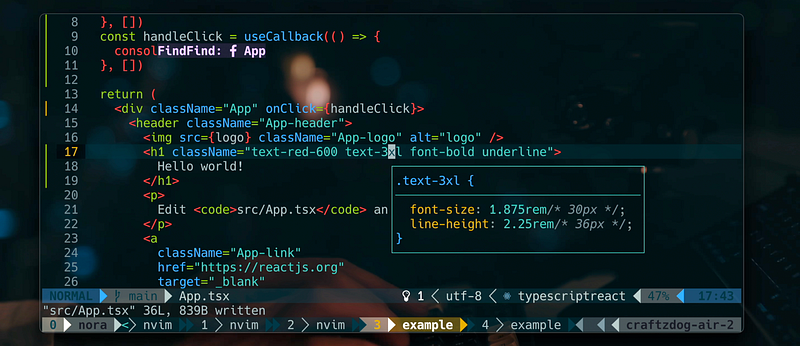
If you need additional LSP support for specific libraries, you may need williamboman/mason.nvim and williamboman/mason-lspconfig.nvim. I use them for getting Tailwind CSS language server to work on Neovim.
local status, mason = pcall(require, "mason")
if (not status) then return end
local status2, lspconfig = pcall(require, "mason-lspconfig")
if (not status2) then return end
mason.setup({})
lspconfig.setup {
ensure_installed = { "sumneko_lua", "tailwindcss" },
}Add lspconfig:
local nvim_lsp = require "lspconfig"
nvim_lsp.tailwindcss.setup {}That’s pretty much it! I hope it’s helpful for improving your Neovim environment.
Follow me online
- Check out my app called Inkdrop — A Markdown note-taking app
- Twitter https://twitter.com/inkdrop_app
- Blog https://www.devas.life/
- YouTube https://www.youtube.com/devaslife
- Instagram https://instagram.com/craftzdog





